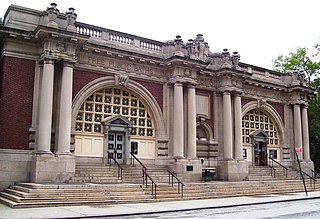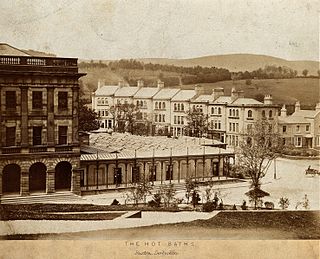
The James Lick Baths (also known as the People's Laundry Building and 165 Tenth Street) in the South of Market District of San Francisco, California is a San Francisco Designated Landmark combining aspects of public bathing and self-service laundry.

The James Lick Baths (also known as the People's Laundry Building and 165 Tenth Street) in the South of Market District of San Francisco, California is a San Francisco Designated Landmark combining aspects of public bathing and self-service laundry.
In 1890 working class residents of San Francisco did not have indoor plumbing. Built in 1890 by the James Lick estate as a free public bath house, it housed a men’s bath with forty bathtubs in changing rooms in the large north wing, and a women’s bath with twenty tubs in changing rooms in the smaller south wing. The James Lick Baths were originally lavish in conception and finish. Water was pumped from the facility’s own wells, heated in boilers in the sunken boiler room, and hot and cold water was pumped into 10,000 gallon tanks in the tower. Bathers could open the taps at each tub in the bathing halls for a customized mix of hot and cold water.
After extensive damage in the 1906 earthquake and fire the building was repaired and continued as a bath until 1919.
From 1919 until 1973 it was The People’s Laundry, an industrial laundry, followed by a variety of offices, workshops, and stores. The two main bath spaces were divided and circulation in the building became convoluted. A wall at the base of the tower was demolished, leaving one side unsupported.
The building became a San Francisco Designated Landmark in 2004. In 2008 Gelfand Partners Architects acquired the building and renovated the ground floor to be its office. [1]

A bathroom, restroom or washroom is a room, typically in a home or other residential building, that contains either a bathtub or a shower. The inclusion of a wash basin is common. In parts of the world e.g. India, a toilet is typically included in the bathroom; in others, the toilet is typically given a dedicated room separate from the one allocated for personal hygiene activities. In the United States, the word 'bathroom' is often used to refer to any room that contains a toilet, regardless of the inclusion of a bath or shower.

In ancient Rome, thermae and balneae were facilities for bathing. Thermae usually refers to the large imperial bath complexes, while balneae were smaller-scale facilities, public or private, that existed in great numbers throughout Rome.

A shower is a place in which a person bathes under a spray of typically warm or hot water. Indoors, there is a drain in the floor. Most showers have temperature, spray pressure and adjustable showerhead nozzle. The simplest showers have a swivelling nozzle aiming down on the user, while more complex showers have a showerhead connected to a hose that has a mounting bracket. This allows the showerer to hold the showerhead by hand to spray the water onto different parts of their body. A shower can be installed in a small shower stall or bathtub with a plastic shower curtain or door. Showering is common due to the efficiency of using it compared with a bathtub. Its use in hygiene is, therefore, common practice.

The Roman Baths are well-preserved thermae in the city of Bath, Somerset, England. A temple was constructed on the site between 60 and 70 AD in the first few decades of Roman Britain. Its presence led to the development of the small Roman urban settlement known as Aquae Sulis around the site. The Roman baths—designed for public bathing—were used until the end of Roman rule in Britain in the 5th century AD. According to the Anglo-Saxon Chronicle, the original Roman baths were in ruins a century later. The area around the natural springs was redeveloped several times during the Early and Late Middle Ages.

Bathing is the act of washing the body, usually with water, or the immersion of the body in water. It may be practiced for personal hygiene, religious ritual or therapeutic purposes. By analogy, especially as a recreational activity, the term is also applied to sun bathing and sea bathing.

The Sutro Baths was a large, privately owned public saltwater swimming pool complex in the Lands End area of the Outer Richmond District in western San Francisco, California.

Public baths originated when most people in population centers did not have access to private bathing facilities. Though termed "public", they have often been restricted according to gender, religious affiliation, personal membership, and other criteria.

A spa is a location where mineral-rich spring water is used to give medicinal baths. Spa towns or spa resorts typically offer various health treatments, which are also known as balneotherapy. The belief in the curative powers of mineral waters goes back to prehistoric times. Such practices have been popular worldwide, but are especially widespread in Europe and Japan. Day spas and medspas are also quite popular, and offer various personal care treatments.

A banya is originally a Russian steam bath with a wood stove. It is considered an important part of Russian culture. The bath takes place in a small room or building designed for dry or wet heat sessions. The steam and high heat make the bathers perspire. Genders were traditionally segregated in the banya, with separate rooms for each sex.

A frigidarium is one of the three main bath chambers of a Roman bath or thermae, namely the cold room. It often contains a swimming pool.

Tremont House, sometimes called the Tremont Hotel, was a hotel designed in 1829 by Isaiah Rogers in Boston, Massachusetts. Notable guests included Davy Crockett and Charles Dickens.

Berkeley Springs State Park is situated in the center of Berkeley Springs, West Virginia, USA. The centerpiece of the Park is its historic mineral spa. These waters were celebrated for their medicinal or restorative powers and were generally taken internally for digestive disorders, or bathed in for stress relief. Native peoples visited these springs as did George Washington. Berkeley Springs is the only state-run spa in the United States and is operated by the West Virginia Division of Natural Resources.

The Baths of Agrippa was a structure of ancient Rome, Italy, built by Marcus Vipsanius Agrippa. It was the first of the great thermae constructed in the city, and also the first public bath.

Bathhouse Row is a collection of bathhouses, associated buildings, and gardens located at Hot Springs National Park in the city of Hot Springs, Arkansas. The bathhouses were included in 1832 when the Federal Government took over four parcels of land to preserve 47 natural hot springs, their mineral waters which lack the sulphur odor of most hot springs, and their area of origin on the lower slopes of Hot Springs Mountain.

In sports therapy, an ice bath, or sometimes cold-water immersion or cold therapy, is a training regimen usually following a period of intense exercise in which a substantial part of a human body is immersed in a bath of ice or ice-water for a limited duration.
Finnila's Finnish Baths—a.k.a. Finnila's—was a Finnish bathhouse and a health club in San Francisco, California. It served the general public from circa 1910 to September, 2000. Finnila's was located in the Castro District of San Francisco for its first 75 years.

Greek baths were bath complexes suitable for bathing and cleaning in ancient Greece, similar in concept to that of the Roman baths. Greek baths are a feature of some Hellenized countries. These baths have been found in Greece, Egypt, Italy, and there is even one located in Marseille, France. Some of the first baths have been dated back to the 5th century BCE. The public baths had a gradual development into the flourishing, culturally-significant structures of the Hellenistic age. The multiple locations of the baths throughout the Mediterranean offer different, culturally-unique developments.

The Buxton Baths using natural thermal spring water are in Buxton, Derbyshire, England. The baths date back to Roman times and were the basis for developing Buxton as a Georgian and Victorian spa town. The present buildings of the Thermal Baths and the Natural Mineral Baths were opened in the 1850s. They are positioned either side of the Buxton Crescent at the foot of The Slopes in the town's Central Conservation Area. They are both Grade II listed buildings designed by Henry Currey, architect for the 7th Duke of Devonshire.

Mayfield Baths was a Victorian washhouse and laundry in Manchester, England that opened in 1857 to serve workers in the surrounding print and textile factories.

The Stabian Baths are an ancient Roman bathing complex in Pompeii, Italy, the oldest and the largest of the 5 public baths in the city. Their original construction dates back to ca. 125 BC, making them one of the oldest bathing complexes known from the ancient world. They were remodelled and enlarged many times up to the eruption of Vesuvius in 79 AD.